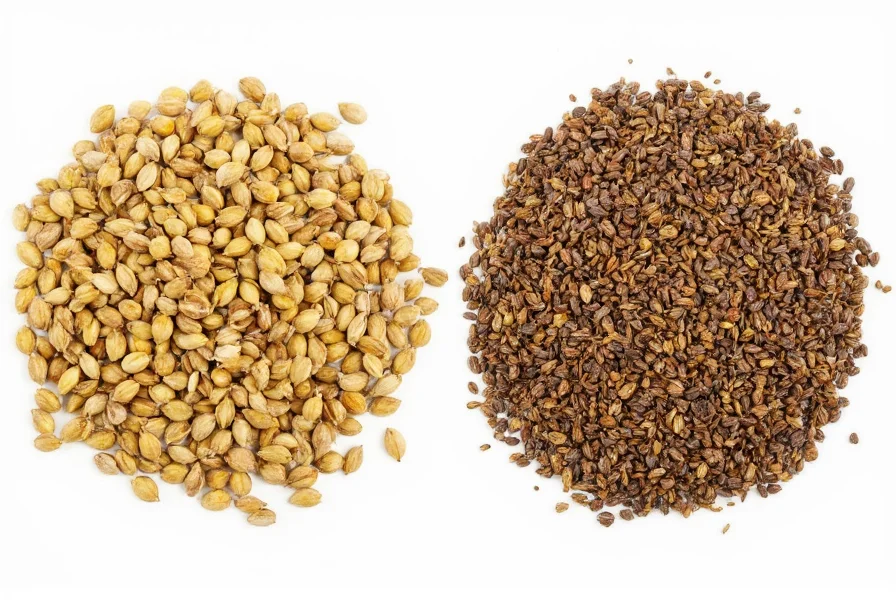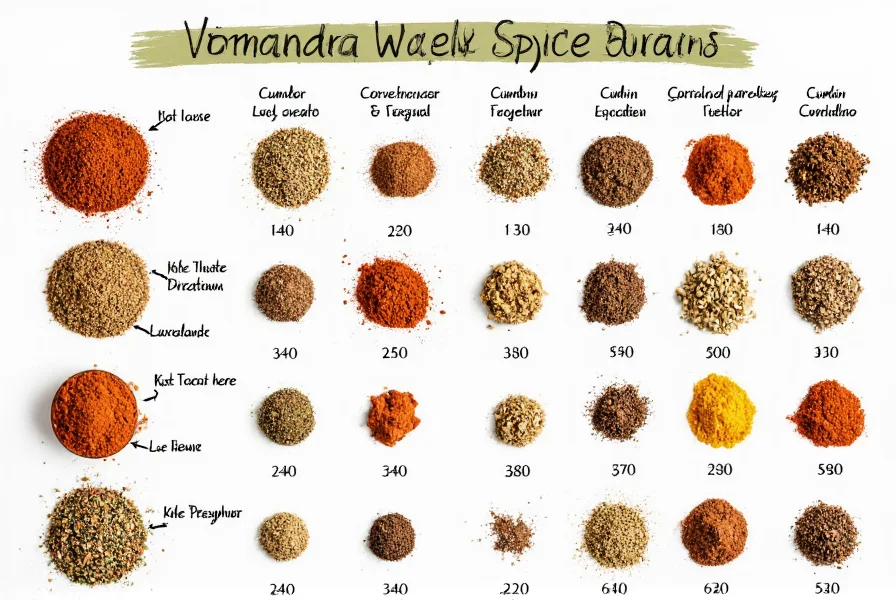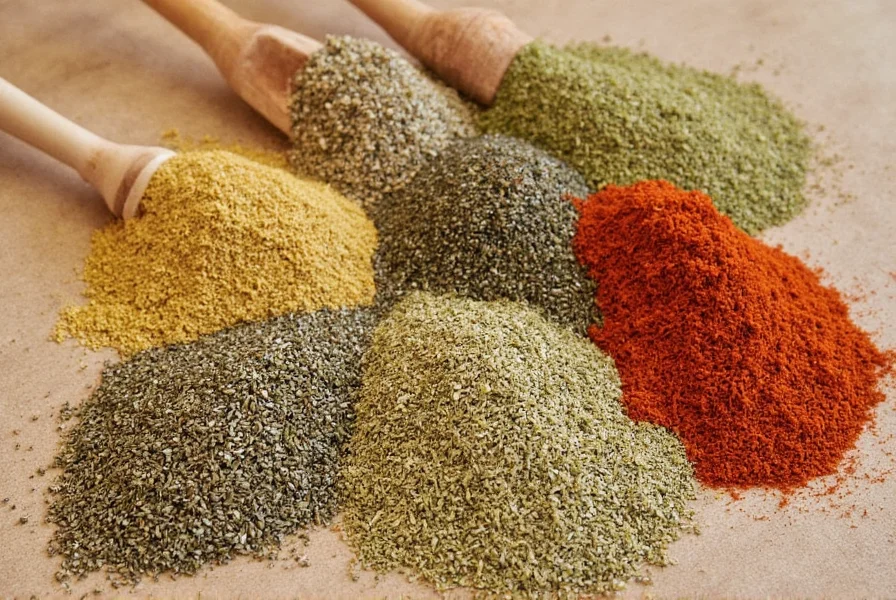No, coriander and cumin are not the same spice. They come from different plants, have distinct flavor profiles, and serve unique purposes in global cuisines. Coriander refers to both the seeds of the Coriandrum sativum plant and the fresh herb (cilantro), while cumin comes from the Cuminum cyminum plant and has a stronger, earthier taste.
Many home cooks and even experienced chefs occasionally confuse coriander and cumin, especially when following international recipes. This confusion often stems from similar packaging, overlapping use in certain spice blends, and regional naming differences. Understanding the distinction between these two essential spices can dramatically improve your cooking results.
What Exactly is Coriander?
Coriander has a dual identity in the culinary world that contributes to the confusion. The term refers to:
- Coriander seeds - The dried fruit of the Coriandrum sativum plant, which has a light, citrusy, slightly sweet flavor
- Coriander herb - More commonly known as cilantro in the Americas, this is the fresh leafy part of the same plant
When recipes specify "coriander" without clarification, they're typically referring to the seeds, especially in British and Commonwealth countries. In the United States, "coriander" usually means the seeds while "cilantro" refers to the fresh leaves.
Understanding Cumin: The Bold Spice
Cumin comes from a completely different plant (Cuminum cyminum) in the same Apiaceae family but with distinctive characteristics:
- Earthy, warm, and slightly bitter flavor profile
- Stronger, more pungent aroma than coriander
- Often described as having notes of lemon and spice
- Used extensively in Mexican, Indian, Middle Eastern, and North African cuisines
Cumin seeds are larger than coriander seeds and have a more pronounced ridged appearance. When toasted, cumin releases an intense aroma that forms the flavor foundation for many spice blends including garam masala, chili powder, and curry powders.

Key Differences Between Coriander and Cumin
| Characteristic | Coriander | Cumin |
|---|---|---|
| Botanical Source | Coriandrum sativum | Cuminum cyminum |
| Flavor Profile | Citrusy, light, slightly sweet | Earthy, warm, slightly bitter |
| Seed Appearance | Rounded, light tan, smooth surface | Oblong, darker brown, ridged surface |
| Common Culinary Uses | Indian curries, pickling, baking, Middle Eastern dishes | Mexican dishes, chili, curry powders, North African tagines |
| Substitution Possibility | Caraway or fennel seeds (partial) | Coriander cannot substitute for cumin's strong flavor |
Why People Confuse Coriander and Cumin
Several factors contribute to the persistent confusion between these spices:
Regional naming differences: In some countries, particularly in parts of Asia, the terms are used interchangeably or with different meanings than in Western culinary contexts. This creates confusion when following international recipes.
Similar packaging: Both spices often appear as small, brownish seeds in spice aisles, making visual identification challenging for beginners. Many grocery stores place them next to each other, reinforcing the misconception they're related.
Shared culinary applications: Both spices feature prominently in curry powders and other spice blends, leading some to assume they're variations of the same ingredient rather than distinct components.
Can You Substitute One for the Other?
While coriander and cumin share some culinary applications, they're not direct substitutes. Understanding the difference between coriander and cumin taste profiles is crucial for successful substitution:
Using cumin in place of coriander will create a much stronger, earthier flavor that may overpower delicate dishes. The reverse substitution (coriander for cumin) typically results in a dish lacking the deep, warm notes that cumin provides.
If you must substitute, consider these approaches:
- For coriander: Caraway seeds or a small amount of fennel seeds can provide a similar citrus note
- For cumin: A combination of coriander, chili powder, and a pinch of smoked paprika might approximate cumin's complexity
Professional chefs emphasize that understanding the difference between coriander seed vs cumin seed appearance helps prevent mistakes before they happen. Coriander seeds are rounder and lighter in color, while cumin seeds are more oblong with distinctive ridges.

Practical Tips for Using Each Spice
To maximize the flavor potential of both spices:
For coriander: Lightly toast the seeds before grinding to enhance their citrus notes. Coriander works particularly well with fish, vegetables, and lighter meat dishes. It's essential in Indian dhania powder and many Middle Eastern spice mixes.
For cumin: Toast cumin seeds in a dry pan until fragrant before using. This intensifies their earthy flavor without making them bitter. Cumin forms the backbone of many chili recipes, taco seasonings, and robust curries where its strong flavor can shine.
When exploring coriander and cumin in Indian cooking, note that many traditional recipes use both spices together but in specific ratios that balance their contrasting flavors. The difference between coriander and cumin becomes particularly important in dishes where one spice should dominate the flavor profile.
Final Clarification
The persistent question "are coriander seeds the same as cumin" has a definitive answer: no. While both belong to the Apiaceae family of plants, they come from different species with unique chemical compositions that create distinctly different flavors and aromas.
Recognizing why people confuse coriander and cumin helps prevent culinary mistakes. By understanding their individual characteristics and proper applications, you can elevate your cooking and create more authentic international dishes. The next time you're wondering whether to reach for coriander or cumin, remember their fundamental differences in flavor, appearance, and culinary purpose.
Can I use coriander instead of cumin in chili?
While possible in a pinch, substituting coriander for cumin in chili significantly changes the flavor profile. Cumin provides the earthy, warm base note essential to traditional chili, while coriander offers a lighter, citrusy flavor. For better results, use a combination of coriander, smoked paprika, and a small amount of chili powder to approximate cumin's depth.
Why do some recipes call for both coriander and cumin?
Many global cuisines intentionally use both spices together to create complex flavor layers. In Indian cooking especially, the citrus notes of coriander balance the earthiness of cumin, creating a more nuanced taste profile. This combination appears in curry powders, garam masala, and many regional spice blends where their contrasting flavors complement rather than compete with each other.
Is ground coriander the same as ground cumin?
No, ground coriander and ground cumin come from different plants and have distinct flavor profiles. Ground coriander has a light, citrusy flavor while ground cumin is stronger, earthier, and more pungent. They should not be used interchangeably in recipes as they create significantly different results.
What's the difference between cilantro and coriander?
Cilantro refers to the fresh leaves and stems of the Coriandrum sativum plant, while coriander typically refers to the dried seeds of the same plant. In some regions (particularly the UK and Commonwealth countries), "coriander" refers to both the seeds and the fresh herb, which adds to the confusion. In the United States, "coriander" usually means the seeds while "cilantro" means the fresh herb.
Which spice has a stronger flavor, coriander or cumin?
Cumin has a significantly stronger, more pungent flavor than coriander. Cumin's earthy, warm notes dominate dishes, while coriander provides a lighter, citrusy background note. This difference in intensity explains why many recipes use more coriander than cumin when both appear in the same dish.











 浙公网安备
33010002000092号
浙公网安备
33010002000092号 浙B2-20120091-4
浙B2-20120091-4